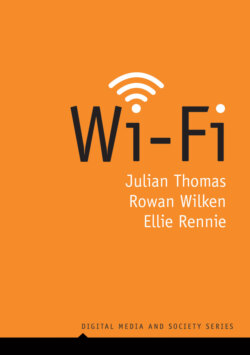Читать книгу Wi-Fi - Ellie Rennie - Страница 11
Wi-Fi combines new and old technologies
ОглавлениеWi-Fi is best approached not as a single technology, but as a large and diverse group of technical innovations which have been brought together under a single banner. These function as agreed protocols – rules for critical functions such as encryption, addressing, error correction, channel spacing, and power outputs. These are assembled for an agreed purpose – local wireless networks – which itself is likely to evolve, and they address a changing array of problems. Novel techniques are included, but one of the reasons for Wi-Fi’s low cost is that it combines many pre-existing innovations, some of them already covered by well-known industry standards. So Wi-Fi makes full use of the tricks used by wired ethernet networks for handling data packets. It uses the internet’s underlying protocols for directing data flows, together with ‘spread spectrum’ and ‘frequency hopping’ techniques for sharing radio frequencies, which are also used in other wireless communication systems, such as Bluetooth for short-range devices, and GPS for satellite navigation.
In these respects, Wi-Fi is a good example of Brian Arthur’s observations about the piecemeal, combinatorial aspects of technological evolution (Arthur, 2010). The most significant Wi-Fi innovations involve the assembly of many layers of techniques and practices, the documentation and stabilization of the system through standard-setting, and the integration of this bundle of technologies into hardware and software. Standards and marketing play a major role in market formation, creating economies of scale for further innovation. Companies such as Apple are then well positioned to champion new standards.
The critical achievement for any emergent technology such as Wi-Fi is the overall assembly of new and old techniques, combined with consensus about shared objectives. The next stage is a protracted process of internal and incremental innovation, whereby particular components within the assembly are replaced with marginally improved or revised versions in response to known and anticipated problems. After all, Wi-Fi does something inherently difficult: it transmits and receives large volumes of data from multiple users using shared radio frequencies in spaces that are not designed for the purpose. The problems are manifold: wireless networks must deal with interference from devices using the same frequencies; they must provide secure communications; within buildings, transmissions need to deal with physical objects, especially walls and floors, which signals can bounce off or fail to pass through. Revised and faster versions of Wi-Fi need to deal with devices using older versions: do these slow down the entire network? As additional and different kinds of connected devices appear – such as phones, tablets, and smart TVs – how do we manage the multiplying number of connections? And, as more of those devices are battery powered, and as energy consumption across the network becomes an increasingly pressing question, how do we increase the overall efficiency of the system?
The recent history of Wi-Fi is often framed around a progressive narrative about increasing network speeds, where each new version of the technology generates an impressive leap in the claims made about maximum bit rates – claims which rarely translate directly into reality. Although improvements in speed are important, the many iterations of Wi-Fi (and the resulting alphabet soup) are better understood as an accretion of new technical solutions within the overall assemblage, together with evolutionary improvements in the core capabilities.
